African Arts/Handicraft and Environmental Management Institute (AFHEMI)
 Beaded Wooden Mask |
The AFHEMI Museum was officially inaugurated in Yaounde, Cameroon, by the Ministry of Culture on October 20, 1999, but is now permanently closed. The Museum collection included over two thousand traditional art objects, artifacts, antiquities and paintings, some of which were more than nine hundred years old. The objects were made of wood, bronze, copper, silver, brass, and fired clay. The collection included ritual and ceremonial masks, statues, royal beds and utensils, healing art works and power mediums and vectors of good omens and repellants of dangerous charms. The collection was also rich in traditionally hand-woven fabric, hand-embroidered cloth, mud cloth, tie-dyed fabric, batik, and beaded objects. Bamboo and raffia works also abounded in various traditional forms, both ancient and modern. |
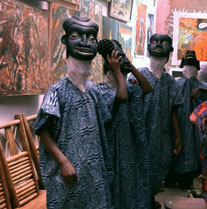 |
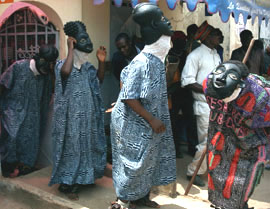 |
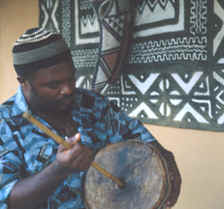 |
| Performance at the AFHEMI Museum with pieces from the collection | Godlove Kinni playing a musical instrument from the collection | |
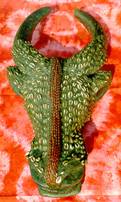 |
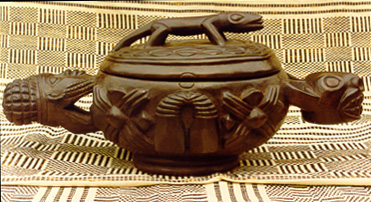 |
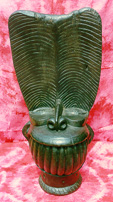 |
| Buffalo Totem, Tikar | Royal Bowl, Tikar | Bacham, Bamileke |
| These three pieces are from CAMEROON |
|
The museum had five main objectives: 1. Collection, Documentation, and Exhibition: -Research, document, and promote the traditional music and choreographies and dance expressions of Cameroon and Africa. -Collect and exhibit art objects/works from various regions of Cameroon and Africa. -Keep a detailed inventory of the symbolism, philosophy, rituals and social functions of the objects in the collection. -Collect and document the oral histories and traditions of the various tribes and peoples of Cameroon and Africa. -Publish books for children related to the arts and cultures of Cameroon and Africa. -Rewrite the history of Cameroon and Africa from the oral and ritual traditions collected from various communities. -Organize annual exhibitions for artists and artisans. 2. Conservation, Restoration, and Education: -Research, develop, conserve, and restore the art objects in the collection. -Teach the art of collection, documentation and conservation. -Establish relationships with local and foreign museums. -Teach creative production and finishing in a variety of media (i.e. batik, tie dye, printing, weaving, embroidery, clothing design and production, bronze casting, carving, painting, etc.) -Teach crafts to the underprivileged. 3. Exchange Educational, Research, and Cultural Programs: -Organize traveling exhibitions for Cameroonian and foreign museums. -Develop cross-cultural exchange through tourism, educational and research programs, and school projects. -Accept Consulting/Lecturing/Research invitations from any University/Organization/Institute in the world. 4. Environmental Protection and Enhancement: -Develop an art botanical garden to encourage the growing of plants that are useful to artists and artisans. -Identify, study, and raise the types of shrubs and trees used by artists and artisans to produce works, traditional dyes, preservatives, and emulsions for preservation techniques. 5. Marketing: -Create a cooperative for selling arts and crafts of high quality. |
| Kini-Yen Design clothing was also available through the museum. | ||
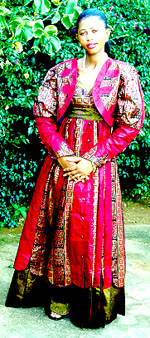 |
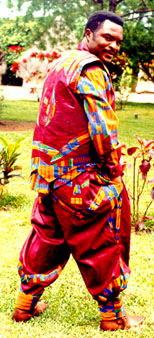 |
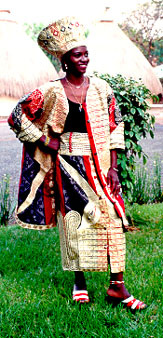 |
Links:
Art-Batik of Adehoumi Sikirou Shola
Bark Pictures of Claude Ngaha
Metal Casting in Foumban
Ceramics of Foumban
Dschang Handicraft Center
Gîtes Ruraux de l'Ouest
Wood Carving in Foumban
Abdou Mfopa
Cameroonian beadworking
Tapestry Crochet in Cameroon
Cameroonian Basket Maker, Fokam Goufo Buhler
Cameroonian Author, Mih John Fung
Cameroonian Painter, Hilarion Wirdzeka Faison
Nigerian Painter, Elcarver Rotimi Agbola
Web page, photographs, and text by Carol Ventura in 2001. Please look at Carol's home page to see more about crafts around the world.
Art-Batik of Adehoumi Sikirou Shola
Bark Pictures of Claude Ngaha
Metal Casting in Foumban
Ceramics of Foumban
Dschang Handicraft Center
Gîtes Ruraux de l'Ouest
Wood Carving in Foumban
Abdou Mfopa
Cameroonian beadworking
Tapestry Crochet in Cameroon
Cameroonian Basket Maker, Fokam Goufo Buhler
Cameroonian Author, Mih John Fung
Cameroonian Painter, Hilarion Wirdzeka Faison
Nigerian Painter, Elcarver Rotimi Agbola
Web page, photographs, and text by Carol Ventura in 2001. Please look at Carol's home page to see more about crafts around the world.